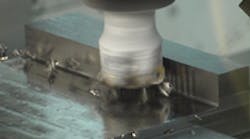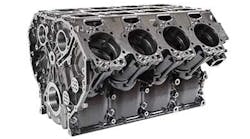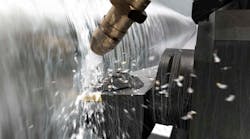Live cryogenic machining of titanium at IMTS 2010 demonstrated the performance capabilities of the new system.
Titanium is everywhere. It’s the metal of the moment for all manner of demanding and high-value product designs, from aerospace to power generation to medical equipment components. But, titanium is hard, and hard to machine. It’s expensive too, putting a high priority on the need to get the machining done right, and of course, quickly.
A technique developed by MAG and highlighted in its presentations at IMTS 2010 uses a through-spindle, through-tool cooling system. A number of patents are pending for this “cryogenic machining” development, which MAG touts for its effective and efficient cooling of the tool’s cutting edge — “more efficiently than ever before possible,” MAG states — which leads to much higher cutting speeds for faster metal removal and/or longer tool life. A combination of these two advantages is a third possibility.
Interviewed by American Machinist at IMTS 2010, a MAG engineer confirmed that the process continues to be the subject of extensive commercial trials, in critical applications. Full commercialization is expected soon.
The process involves a low-temperature (-321°F) liquid nitrogen cooling system that also can be combined with MQL (minimum quantity lubrication) to reduce tool friction and adhesion: this is the key to higher metal removal rates or longer tool life. Ideal applications for this technique involve aggressive metal removal in the hardest workpiece materials, such as titanium, nickel-based alloys, and nodular or compacted-graphite iron (CGI).
MAG’s through-spindle cryogenic cooling system is suitable for motorized, belt-driven, or geared spindles.
"We are still in development, but have achieved 60-percent speed increases in milling CGI with carbide, and up to four times using PCD (polycrystalline diamond) tooling. With the addition of MQL, we tripled speeds with carbide, but showed no further benefit to the fourfold increase with PCD," explained MAG vice chairman, technology – global, Dr. Wolfgang Horn. "These tests focused on metal-removal increases, while keeping tool life equal to what would be achieved with conventional coolants. Early results indicate this technology could dramatically improve the lifecycle cost model for machining in a 'hard-metal' environment by reducing the required number of machines and associated plant infrastructure, or possibly increasing tool life beyond anything thought possible today.
“Cost-wise, cryogenic machining becomes even more competitive when you consider it's a non-issue environmentally,” Horn continued. “There is no mist collection, filtration, wet chips, contaminated workpieces or disposal cost, and certainly less energy consumption without all the pumps, fans and drives that go into handling coolant."
He explained that the efficiency of MAG’s cryogenic through-tool cooling technique is its ability to concentrate the cooling effect in the body of the cutting insert. "Cryogenic machining has never been done this efficiently before, with liquid nitrogen passed through the spindle and into the insert," he explained. "Through-tool cooling provides the most efficient heat transfer model, and consumes the least amount of liquid nitrogen. Our development work to date has focused on milling and boring, where consumption has been about 0.04 liters per minute per cutting edge. We believe drilling and tapping should be even less."
Chart shows tool life and speed gains for carbide tool in CGI when using through-tool cryogenic cooling, and cryogenic cooling with Minimum Quantity Lubrication. (Source: MAG)
Horn added that MAG’s testing has demonstrated cryogenic cooling will allow the range of capabilities for diamond tooling to be expanded significantly, for example extending the heat limit in CGI by 3 to 4 times. Carbide tooling, which is more affected by abrasive wear, responds best when MQL is combined with cryogenic cooling.









